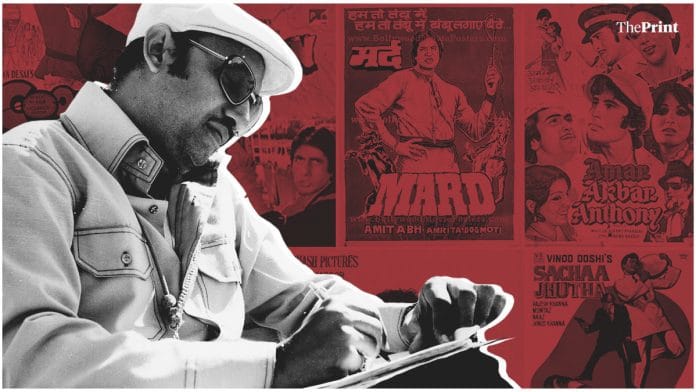New Delhi: “This is such a masala movie, leave your brain at home when you go to watch it.” It is an oft-repeated remark when talking about a Bollywood flick.
Of course, the tide has changed significantly in the past few years, with a number of films that are entertaining yet not brain-deadening. But the masala tag sticks, and is now used as an umbrella term for a film that has it all — dreamy songs, high drama, improbable action sequences, weepy emotion and an enormous amount of suspension of disbelief. It is what makes Bollywood unique and so highly popular. And one of the people we have to thank for making mainstream Indian cinema what it is today is Manmohan Desai, the blockbuster director and producer.
Desai was born in Mumbai on 26 February 1937 into a filmy family. His father Kikubhai Desai was a producer and director known for making stunt films. After dropping out of college, Desai got his break in films thanks to his brother Subhash Desai, also a producer. In 1960, he debuted with Nutan and Raj Kapoor-starrer Chhalia, which was about a family torn apart during Partition. It was a hit, and Desai set upon an industry-defining career.
Also read: Amar Akbar Anthony is the perfect thematic prequel to Mulk
Bollywood’s magic masala
Be it films like Amar Akbar Anthony (1977), Parvarish (1977), Naseeb (1981), or Coolie (1983), there is something that keeps you glued to the screen, despite the knowledge that this isn’t intellectual cinema. What it is, however, is intelligent cinema — which Desai knew just how to make. The director, who worked with the biggest stars of the 1960s, ’70s, and ’80s, had a knack for tapping into the audience’s pulse and using that to make engaging cinema.
A recurring theme in many of his films was the importance of family and his favourite trope to underline this was the ‘lost-and-found’ plot. Take for example, perhaps his most famous film, Amar Akbar Anthony. The madcap multistarrer had Amitabh Bachchan, Rishi Kapoor and Vinod Khanna play brothers who, separated in childhood, grow up following different faiths and eventually, via a circuitous route involving crime, romance and much song and dance, reunite, defeat the criminals and live happily ever after with their respective partners (Parveen Babi, Neetu Singh and Shabana Azmi).
The film was one of the highest-grossing films of the 1970s and remains a cult classic.
Its famous opening credits scene (which comes half an hour into the movie) shows the three brothers, at the moment strangers, donating blood to save their blind mother, by hooking up three tubes into one blood bag as a song plays about the importance of blood and blood relatives.
It’s a long leap away from how it works in reality. Most people working on the film felt that way too, and told Desai he was stretching it. But the director was adamant and the audience loved it. Even today, if the most discerning viewer saw the scene, they may scoff, but they won’t be able to deny its dramatic effect. It symbolises the coming together of the brothers, of their diverse religions and, most importantly, the importance of family. And the Indian audience lapped it up.
Desai’s first decade in the film industry was good — he delivered mass-y films for an entertainment-hungry audience. But his golden era came in the ’70s, when he started working with Bachchan. Their first film together was Parvarish, which was shot alongside Amar Akbar Anthony. Both films did exceedingly well, and their partnership was sealed.
As Bachchan once recounted, it was a specific scene from Amar Akbar Anthony that cemented this creative collaboration. Bachchan shot his iconic ‘drunken monologue in front of a mirror’ scene when Desai, having given instructions about the scene, had left to go to the other film’s set.
“He took me aside after the rushes were seen, and we sat on the steps of the portico of that dilapidated studio and he said to me, ‘Lalla (an affectionate way of addressing someone), so long as I make films, you will always be in them. You may not work with me, but I shall always work with you.’ And he kept his word to the last day. He never directed a film without me after that day!!” Bachchan said.
The duo went on to make some of the biggest hits of both their careers together: Naseeb, Coolie, Desh Premee. The director also worked multiple times with Shatrughan Sinha, Shammi Kapoor, Shashi Kapoor and Randhir Kapoor. He delivered four back-to-back hits in just 1977, yet, as Bachchan recalled, he was extremely down-to-earth, choosing to live in a cramped, tiny apartment in Mumbai despite making enough money to buy more than one house.
A product of his time
While Desai’s work and creative talent are praised even today, it is important to acknowledge that he wasn’t as perfect as the stories he told. He was a self-proclaimed womaniser, and had a troubled marriage. He was egotistical and obsessive.
After the death of his first wife, Jeevanprabha Desai, in 1979, he remained single until he met actor Nanda. He was obsessed with her to the point where he would reportedly shoot scenes near her house in hopes of catching a glimpse of her. Desai asked her to marry him in 1992, and she agreed, but tragedy struck before they could officially tie the knot.
Desai fell to his death from his balcony in 1994. It is yet unconfirmed whether it was suicide or an accident, but he left many fans hoping for a resurrection, just like one of his films.
Also read: How Kader Khan’s dialogues made Devdas look cool in Muqaddar Ka Sikandar






